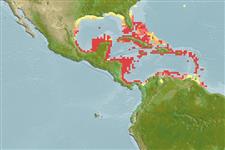Common names from other countries
Teleostei (teleosts) >
Eupercaria/misc (Various families in series Eupercaria) >
Scaridae (Parrotfishes) > Sparisomatinae
Etymology: Sparisoma: Latin, sparus = a fish with a golden head + Greek, soma = body (Ref. 45335).
More on author: Valenciennes.
Environment: milieu / climate zone / depth range / distribution range
Ecology
Marine; reef-associated; depth range 2 - 20 m (Ref. 9710). Subtropical; 33°N - 8°N, 98°W - 51°W
Western Atlantic: throughout the Caribbean Sea.
Length at first maturity / Size / Weight / Age
Maturity: Lm ?, range 15 - ? cm
Max length : 28.0 cm TL male/unsexed; (Ref. 7251); common length : 20.0 cm TL male/unsexed; (Ref. 3802)
Short description
Morphology | Morphometrics
Dorsal
spines
(total): 9;
Dorsal
soft rays
(total): 10;
Anal
spines: 3;
Anal
soft rays: 9. Adults of both sexes have distinct white spot behind base of dorsal fin; super males with red line from corner of mouth to below back of eye; and 2 or more jet-black spots on side above pectoral fin (Ref. 26938). The smaller color phase is brown or greenish brown with a dark blue cast on the back and sides, becoming red ventrally (Ref. 13442).
Inhabits coral reefs, young usually in adjacent seagrass beds. Often rests on the bottom (Ref. 9710). Feeds on plants. Solitary or in small groups. A protogynous hermaphrodite (Ref. 55367).
Life cycle and mating behavior
Maturity | Reproduction | Spawning | Eggs | Fecundity | Larvae
A monandric species (Ref. 55367). Length at sex change = 17.5 cm TL (Ref. 55367). Forms harem groups composed of a single male and several smaller females (Ref. 55367). Also Ref. 103751.
Robins, C.R. and G.C. Ray, 1986. A field guide to Atlantic coast fishes of North America. Houghton Mifflin Company, Boston, U.S.A. 354 p. (Ref. 7251)
IUCN Red List Status (Ref. 130435)
CITES (Ref. 128078)
Not Evaluated
Threat to humans
Reports of ciguatera poisoning (Ref. 30303)
Human uses
Fisheries: minor commercial; aquarium: commercial
More information
ReferencesAquacultureAquaculture profileStrainsGeneticsElectrophoresesHeritabilityDiseasesProcessingMass conversion
Tools
Special reports
Download XML
Internet sources
Estimates based on models
Preferred temperature (Ref.
115969): 26.3 - 28.2, mean 27.5 (based on 491 cells).
Phylogenetic diversity index (Ref.
82804): PD
50 = 0.5000 [Uniqueness, from 0.5 = low to 2.0 = high].
Bayesian length-weight: a=0.01072 (0.00649 - 0.01768), b=3.13 (2.99 - 3.27), in cm Total Length, based on LWR estimates for this species & Genus-body shape (Ref.
93245).
Trophic level (Ref.
69278): 2.0 ±0.1 se; based on diet studies.
Resilience (Ref.
120179): Medium, minimum population doubling time 1.4 - 4.4 years (K=0.20).
Fishing Vulnerability (Ref.
59153): Low vulnerability (22 of 100).
